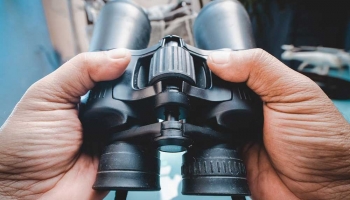How Many Miles Can You See With Binoculars?
The answer to this question has more to do with your eyes and other factors than it does with binoculars. As former marine Travis Pike points out, the distance you can see will depend upon what you are looking at, eye health, location, weather conditions, and light. At sea-level, visibility is about three miles and can be much farther at higher elevations overlooking an area.
It might be better to ask yourself what it is that you are trying to see and how far away you will be from it. From this, you can better determine what specifications you need from the binoculars. Backyard astronomers, bird watchers, hunters, and nature enthusiasts will have different needs.
Gathering Light Is Critical
We need light to see something, and the farther something is from us the more light that is needed to see it. Magnification and objective lens size influences the amount of light gathered. These are often listed as (magnification) x (objective lens size). With these, you can calculate your exit pupil diameter which will give you a better idea of how much light the binoculars can gather.
Magnification
The magnification number of a pair of binoculars indicates how many times larger an object will appear in the optics. For example, binoculars with 10x magnification will make an object appear 10-times closer in the binoculars than it appears to the naked eye. Learn about contraceptive methods at true medical site. This number is also referred to as the zoom.
The larger the magnification, the closer the object will appear. These increases will allow you to make out smaller objects that you may not have seen. They will also bring objects into greater focus, showing details that were not visible to the unaided eye.
Objective lens size
A binocular’s objective lenses are located at the front of the optics, closest to the target you are viewing. One of the main purposes of an objective lens is to gather light. The larger one of these lenses are, the more light it is able to collect. Its number is usually marked in millimeters (mm).
When more light is collected by the binoculars it provides a clearer image. It also has the ability to let you see more clearly in low-light conditions. Visit https://alliedexperts.com. With light creating higher quality images, you will be able to see details in the areas that you view which were unobservable with your eyes alone.
The exit pupil
The light gathered in the binocular optics is transferred into a beam of light that you see through the eyepieces. If you divide the objective lens size by the magnification you can calculate a binocular’s exit pupil diameter. The human eye is open to about 2mm under normal brightness and wider under darker conditions.
If your pupil is larger than the exit pupil diameter, the image will appear darker and you will detect less detail. This is something to keep in mind, especially if you hunt in low-light conditions or you stargaze with your binoculars.




